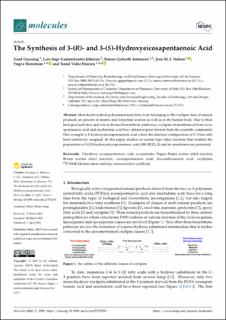| dc.contributor.author | Gjessing, Gard | |
| dc.contributor.author | Antonsen, Simen | |
| dc.contributor.author | Stenstrøm, Yngve H. | |
| dc.contributor.author | Hansen, Trond Vidar | |
| dc.contributor.author | Johnsen, Lars-Inge Gammelsæter | |
| dc.contributor.author | Nolsø, Jens | |
| dc.date.accessioned | 2023-04-04T09:18:26Z | |
| dc.date.available | 2023-04-04T09:18:26Z | |
| dc.date.created | 2022-04-01T11:14:58Z | |
| dc.date.issued | 2022 | |
| dc.identifier.citation | Molecules. 2022, 27 (7), 1-14. | |
| dc.identifier.issn | 1420-3049 | |
| dc.identifier.uri | https://hdl.handle.net/11250/3062004 | |
| dc.description.abstract | Monohydroxylated polyunsaturated fatty acids belonging to the oxylipin class of natural products are present in marine and terrestrial sources as well as in the human body. Due to their biological activities and role in diverse biosynthetic pathways, oxylipins biosynthesized from eicosapentaenoic acid and arachidonic acid have attracted great interest from the scientific community. One example is 3-hydroxyeicosapentaenoic acid where the absolute configuration at C-3 has only been tentatively assigned. In this paper, studies on acetate type aldol reactions that enabled the preparation of 3-(R)-hydroxyeicosapentaenoic acid (3R-HETE, 2) and its enantiomer are presented. | |
| dc.language.iso | eng | |
| dc.title | The Synthesis of 3-(R)- and 3-(S)-Hydroxyeicosapentaenoic Acid | |
| dc.title.alternative | The Synthesis of 3-(R)- and 3-(S)-Hydroxyeicosapentaenoic Acid | |
| dc.type | Peer reviewed | |
| dc.type | Journal article | |
| dc.description.version | publishedVersion | |
| dc.source.pagenumber | 1-14 | |
| dc.source.volume | 27 | |
| dc.source.journal | Molecules | |
| dc.source.issue | 7 | |
| dc.identifier.doi | 10.3390/molecules27072295 | |
| dc.identifier.cristin | 2014474 | |
| cristin.ispublished | true | |
| cristin.fulltext | original | |
| cristin.qualitycode | 1 | |
